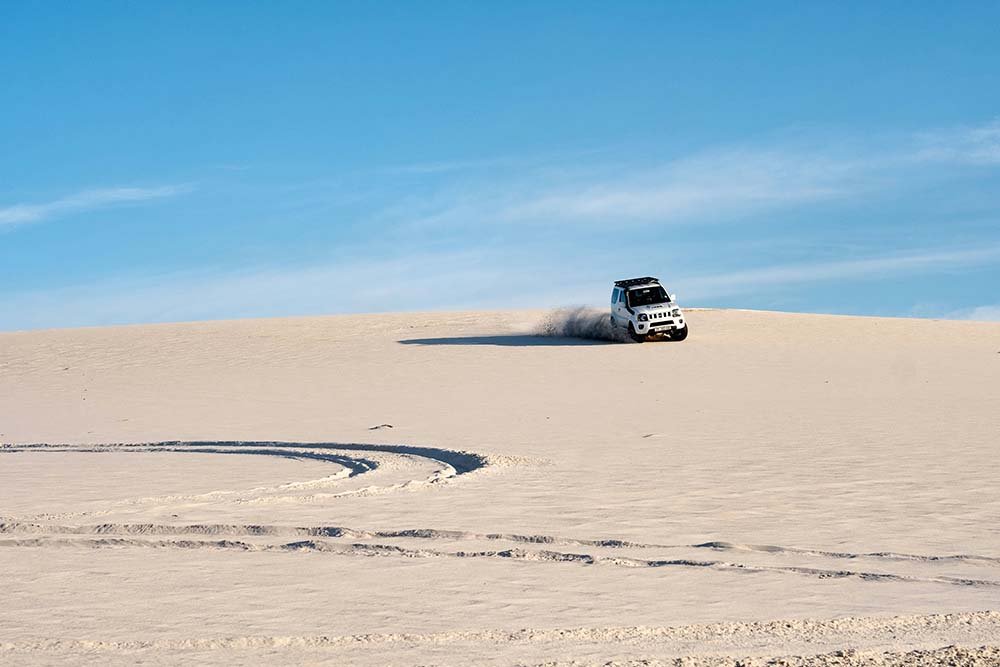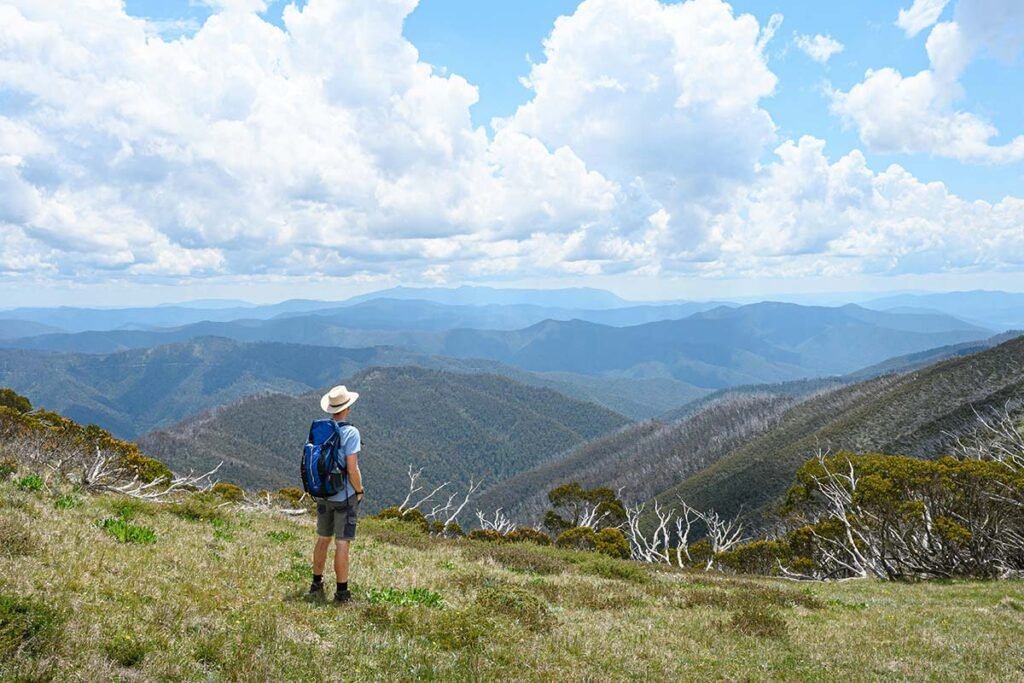Beach driving is one of the great joys of 4WD life. There’s nothing quite like cruising along the coast with the ocean on one side and endless dunes on the other. But it’s also a skill that requires a proper understanding of your vehicle, the terrain and how to recover when things don’t go to plan.
I recently completed a 4WD beach driving course in WA with Eureka 4WD & Truck Training. And I wanted to share a few things I learned—along with a few extra tips—so you can hit the sand safely and confidently. It helped me go from simple sand driving to the toughest 4WD track in WA’s southwest.
Essential beach driving tips in your 4WD
Tyre pressure: the first and most crucial step

Reducing your tyre pressure is arguably the single most important adjustment for beach driving.
- Sand driving pressure: Drop your tyres to 12 PSI when you’re on soft sand. This increases the tyre’s footprint and helps you float on top of the sand rather than dig in. Many will till you the absolute minimum tyre pressure should be 14 or 16 PSI. In fact, even 10 PSI is usually fine.
- Highway pressure: Pump them back up to 40 PSI when you return to sealed roads to maintain safe handling and fuel efficiency.
Pro tip: Never trust the pressure gauge while your compressor is running. Always turn it off and then check the reading.
Using 4WD correctly: high vs low range
Understanding your 4WD settings is vital. Most of the time on the beach, you’ll want to use:
- High range 4WD (H4): Best for driving on the beach and up or down dunes where you need traction but also want to maintain speed
- Low range 4WD (L4): Use this when you’re stuck, climbing technical sections or recovering a vehicle. It gives you maximum torque at lower speeds
Important: Always shift into 4WD while in neutral, especially when moving between high and low range.
Buttons and functions of your vehicle
Today’s 4WDs come with a bunch of features designed to help you—but only if you know what they do.
- Rear differential lock: Use this when one rear tyre is off the ground (like over rocks or uneven terrain). It locks both rear wheels together to push through tough spots.
- Traction control: In many vehicles (like Mitsubishi), traction control is automatic and redirects power to wheels with grip. If you’re stuck, turn it off to stop it cutting power and allow the wheels to spin.
- Stability control (stabiliser button): Usually on by default, it prevents oversteering or understeering. You may want to disable it when stuck to get more control.
- Headlights on always: Even during the day—it helps with visibility in the glare and keeps you seen.
- Leave a 3-car gap: Dust, sand spray and braking distance are all amplified on the beach. More space equals more safety.
Hill climbs: momentum is key

Getting up soft sandy hills is all about choosing the right gear and committing to it.
- Use 2nd gear in high range, build some momentum and don’t back off.
- If you lose traction, reverse back down in a straight line using your own tyre tracks, then try again.
Recovery tips: what to do if you get stuck
Even the best drivers get bogged now and then. Here’s a step-by-step plan:
- Stop spinning. The more you dig, the worse it gets.
- Engage low range, and gently rock back and forth to create some space.
- Turn off traction control. Let the wheels spin a little to gain momentum.
- Clear sand around the tyres and under the diff if needed.
- Check recovery points. Only use points bolted into the chassis, not welded ones—they can snap off and become deadly projectiles.
- Still stuck? Time for a snatch strap recovery—but make sure everyone involved knows what they’re doing.
Essential gear checklist for beach driving
Here’s the gear you should always have with you when heading off-road onto the sand:
- Tyre deflator: For quickly and accurately dropping pressure to 12 PSI
- 12V air compressor: To reinflate tyres when returning to bitumen
- Recovery tracks: Essential for getting out of soft sand when bogged
- Snatch strap and rated shackles: For safe recoveries with another vehicle
- Shovel: To dig out sand around your tyres and under your chassis
- Tyre repair kit: For plugging punctures on the go
- Spare tyre (full size): Space-savers aren’t suitable for off-road recovery
- Rated recovery points: Properly bolted to the chassis, front and rear
- Gloves and recovery dampener: For safer recoveries and protecting your hands
- UHF radio: To communicate with other vehicles, especially in convoys
- First aid kit: Always a good idea, especially in remote areas
- Fire extinguisher: Mandatory in many 4WD clubs and events
Want to download this list? No problem, just click here to download the PDF [124kb], and we’ll send our comprehensive 4WD beach driving checklist will be sent to your inbox.
Extra tips for safe beach driving
- Know the tides. Drive at low tide whenever possible—there’s more firm sand to work with and you’ll avoid getting caught by rising water.
- Go with a mate. Never drive remote beaches alone. Another vehicle is your best recovery gear.
- Stay off vegetation and dunes. It’s illegal in many places, damages fragile ecosystems and ruins access for everyone.
- Drive slowly near others. People, pets and kids don’t expect cars on the beach. Be respectful and alert.
FAQ: Beach 4WDing
Q: What tyre pressure should I use for beach driving?
A: Around 12 PSI, depending on your vehicle and load.
Q: Can I use AWD instead of 4WD on sand?
A: AWD isn’t ideal. You need proper low-range gearing and locking differentials to tackle serious beach terrain.
Q: When should I use low-range 4WD?
A: Use it when you’re stuck, recovering another vehicle or driving over slow, technical terrain.
Q: Should I leave traction control on?
A: Turn it off if you’re stuck to allow your wheels to spin and regain momentum.
Q: Is beach driving safe for my car?
A: Yes—if done properly. Rinse your vehicle after to remove salt and avoid corrosion.
Beach driving is a skill, and just like surfing or rock climbing, the more time you spend doing it, the better you’ll get. Taking a 4WD course was the best investment I made before tackling some of WA’s best coastal tracks—from Red Bluff and Lancelin to Yeagarup and Esperance.
So air down, flick it into high range and go chase that sunset down the beach—but always respect the tides, your fellow drivers and the limits of your vehicle.
Want more great tips like these straight from explorers’ mouths? Check out plenty more Gear & Tips articles to help sharpen your adventure nous.



